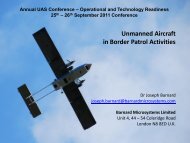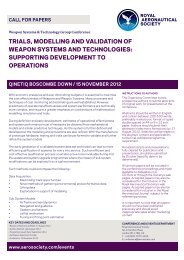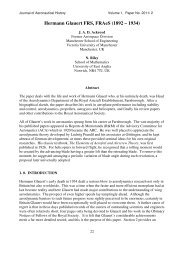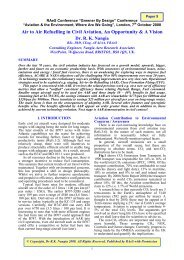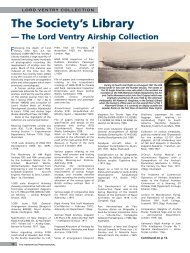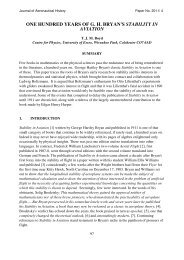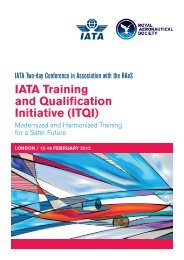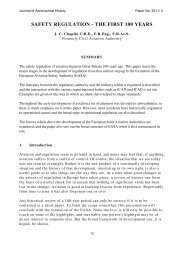The human element in airline training - Royal Aeronautical Society
The human element in airline training - Royal Aeronautical Society
The human element in airline training - Royal Aeronautical Society
Create successful ePaper yourself
Turn your PDF publications into a flip-book with our unique Google optimized e-Paper software.
16<br />
<strong>The</strong> <strong>human</strong> <strong>element</strong> <strong>in</strong> airl<strong>in</strong>e tra<strong>in</strong><strong>in</strong>g<br />
THE TRAINEE PILOT<br />
Long loyal service alone is worth <strong>in</strong>vest<strong>in</strong>g <strong>in</strong>, both f<strong>in</strong>ancially and<br />
<strong>in</strong> other terms. <strong>The</strong> reciprocal <strong>human</strong> <strong>in</strong>vestment of both parties<br />
must rema<strong>in</strong> important and must never simply be discounted.<br />
79. Consideration of the layered cake pr<strong>in</strong>ciple as a teach<strong>in</strong>g<br />
method can be of practical value with some slower th<strong>in</strong>kers, the<br />
late developer or an older pilot who is slow<strong>in</strong>g down. If the end<br />
product is <strong>in</strong> view, it is worth aim<strong>in</strong>g for if only <strong>in</strong> the name of wise,<br />
considerate and car<strong>in</strong>g tra<strong>in</strong><strong>in</strong>g precepts handed down by<br />
enlightened management. In the event, it may well be that certa<strong>in</strong><br />
problem areas could be cleared dur<strong>in</strong>g the l<strong>in</strong>e-fly<strong>in</strong>g phase of<br />
conversion tra<strong>in</strong><strong>in</strong>g. <strong>The</strong> additional costs connotation would<br />
therefore not apply. In the end however, it is accepted that the<br />
criterion on whether to go on with the person's tra<strong>in</strong><strong>in</strong>g or not,<br />
must be the answer to the simple question: Has the student got the<br />
OVERALL CAPACITY to complete the course successfully, or not?<br />
80. It is recognised that term<strong>in</strong>ation of tra<strong>in</strong><strong>in</strong>g is the only<br />
solution <strong>in</strong> certa<strong>in</strong> cases. If one looks back however, not<strong>in</strong>g past<br />
demonstrated ability to which is usually added that normal<br />
<strong>human</strong> trait termed loyalty, it becomes clear that decisions based<br />
on purely monetary grounds need to be tempered with <strong>human</strong>ity.<br />
<strong>The</strong> loyalty of a long time servant needs some recognition. Where<br />
additional tra<strong>in</strong><strong>in</strong>g on new equipment is clearly po<strong>in</strong>tless, an<br />
acceptable compromise without shame can usually be worked out<br />
<strong>in</strong> most cases, to the mutual benefit of all parties <strong>in</strong>volved. What<br />
becomes of the pilot concerned who could cont<strong>in</strong>ue to be<br />
productive on his previous fleet, safely fly<strong>in</strong>g an aircraft that he<br />
knows well, becomes a management problem. Though seldom<br />
encountered, this situation occurs and needs to be considered.<br />
5.5 Breakdown by recognisable type of student<br />
81. Some of the types of student discussed may need similar<br />
handl<strong>in</strong>g by the <strong>in</strong>structor. Guidance on how to deal with each<br />
case should be prepared and similar learner types grouped<br />
together so that closely related handl<strong>in</strong>g needs can clearly be<br />
seen as belong<strong>in</strong>g to a particular group. A scale of student<br />
handl<strong>in</strong>g techniques could be produced to help <strong>in</strong>structor<br />
deal<strong>in</strong>gs with the quiet <strong>in</strong>trovert, the normal personality, the<br />
bounc<strong>in</strong>g extrovert who too may hide a problem, or the<br />
unfriendly and aggressive tra<strong>in</strong>ee. Note that the approach<br />
suggested at a different ‘level’ can also be useful.<br />
82. <strong>The</strong> student types as listed, have been loosely grouped<br />
accord<strong>in</strong>g to their character image. This list is by no means<br />
exhaustive or comprehensive. A number of additional<br />
recognisable types could probably be identified and <strong>in</strong>cluded <strong>in</strong><br />
any further exercise of tra<strong>in</strong>ee type classification.<br />
5.5.1 Group 1<br />
Student Type How to handle<br />
1. <strong>The</strong> generally anxious & sensitive * See 5.4.1<br />
2. Shy and retir<strong>in</strong>g * Direct questions at him<br />
* Ensure that he is<br />
‘brought out’ and <strong>in</strong> all<br />
conversations<br />
* Praise occasionally<br />
before others<br />
3. Meek and apologetic * Needs encouragement<br />
* Give situations that<br />
develop confidence<br />
4. Extremely worried, or * F<strong>in</strong>d reasons tactfully and<br />
generally nervous * Develop his confidence<br />
5. Quiet and passive * May be lack<strong>in</strong>g <strong>in</strong><br />
confidence<br />
6. Silent and churlish * May have a ‘chip on his<br />
shoulder’ (see type 16)<br />
Aircraft of Oxford Aviation Tra<strong>in</strong><strong>in</strong>g.<br />
* F<strong>in</strong>d reasons<br />
7. Preoccupied * F<strong>in</strong>d reason by tactful<br />
question<strong>in</strong>g<br />
8. <strong>The</strong> “Yes I understand”, who * May feel <strong>in</strong>secure, and<br />
unable to admit he did not really * Could need the ‘layered<br />
understand cake pr<strong>in</strong>ciple’ to<br />
demonstrate each po<strong>in</strong>t<br />
well<br />
5.5.2 Group 2<br />
Student Type How to handle<br />
9. <strong>The</strong> jokes artist * Useful to have around as<br />
Or is he the ROGUE one … a safety valve<br />
… who know<strong>in</strong>gly disguises that * Re<strong>in</strong>-<strong>in</strong> so that he does<br />
he is mischievous, troublesome, not take-over us<strong>in</strong>g his<br />
unruly and falls short of the enterta<strong>in</strong>er’s mantle,<br />
required standard? <strong>in</strong>stead of allow<strong>in</strong>g the<br />
lesson to cont<strong>in</strong>ue<br />
* Be aware that he may be<br />
hid<strong>in</strong>g a sense of<br />
<strong>in</strong>security or some<br />
<strong>in</strong>adequacy under a bluff<br />
exterior. Treat<br />
accord<strong>in</strong>gly<br />
10. <strong>The</strong> AVERAGE PILOT * HE is one of the<br />
MAJORITY of people<br />
around<br />
* Accept gratefully<br />
* Enjoy tra<strong>in</strong><strong>in</strong>g him !<br />
11. Active and self confident * Merely an extension of<br />
‘Mr Average’<br />
* Encourage, but provide<br />
object lessons to deter<br />
overconfidence<br />
5.5.3 Group 3<br />
Student Type How to handle<br />
12. <strong>The</strong> ‘Questions’ man. (Dissects * Try object lesson to br<strong>in</strong>g<br />
a pump <strong>in</strong>stead of learn<strong>in</strong>g how home the need for<br />
to use it) application of relevant<br />
knowledge. (L<strong>in</strong>e<br />
Oriented Flight Tra<strong>in</strong><strong>in</strong>g<br />
pr<strong>in</strong>ciples may be useful)



